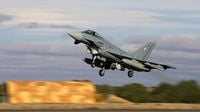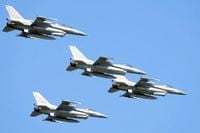In the early hours of August 19, 2025, the fragile sense of security along NATO’s eastern frontier was shattered once again as Russia unleashed a barrage of missiles and drones across Ukraine, some landing perilously close to the border with Romania. The strikes, described by Ukrainian President Volodymyr Zelenskyy as "demonstrative," targeted vital oil and port facilities in the Odesa region—specifically in Izmail, a city hugging the banks of the Danube River, less than a mile from NATO territory. The attacks left Ukrainian cities in flames, families wounded, and the international community on edge, amplifying doubts about Russian President Vladimir Putin’s commitment to any peace process.
According to Romania’s Ministry of Defense, two German Eurofighter Typhoon jets stationed at Mihail Kogălniceanu Air Base were scrambled overnight as part of NATO’s Enhanced Air Policing mission. Their orders: monitor the air situation near the Ukrainian border, where Russian drones had been spotted attacking port infrastructure on the Danube, just across from Romania’s Tulcea County. "Close cooperation with allies in enhanced air policing missions strengthens Romania’s defence capability and contributes to the deterrence and defence posture on NATO's eastern flank," the Romanian Air Force emphasized in a statement cited by Fox News and other outlets. The jets returned to base after completing their monitoring mission, as no Russian aircraft or missiles had crossed into NATO airspace this time around.
This high-alert deployment marked the second time in three days that NATO warplanes were scrambled in response to Russian aggression near alliance borders. The Romanian Ministry of National Defence reported that its air surveillance system had identified "groups of drones launched by the Russian Federation, which attacked Ukrainian ports on the Danube." While no airborne vehicles entered Romanian airspace, the incident underscored how the war in Ukraine continues to threaten the security of neighboring NATO members, raising the stakes for the entire alliance.
Meanwhile, Ukraine’s own air defenses were pushed to their limits. President Zelenskyy reported that more than 60 drones and ballistic missiles were fired across Ukraine overnight, with the Air Force later clarifying that 93 drone strikes had occurred. Ukrainian forces managed to intercept 62 Shahed-style drones and one ballistic missile, but the toll on civilians was grim. In the northeastern city of Sumy, a drone strike left 14 people injured—including children as young as five months, four years, and six years old. "A family with wounded children ... sought assistance after the attack," Zelenskyy revealed, highlighting the human cost of the relentless bombardment. In Donetsk, a Russian glide bomb damaged five apartment buildings, trapping three people beneath the rubble as rescue operations continued into the morning.
"All of these are demonstrative strikes that only confirm the need to put pressure on Moscow, the need to impose new sanctions and tariffs until diplomacy is fully effective," Zelenskyy declared on X (formerly Twitter). He extended his gratitude to partners "who are helping to stop this Russian war," and called for "strong security guarantees to ensure a truly reliable and lasting peace."
The timing of these attacks could hardly be more fraught. Just days earlier, on August 15, President Donald Trump announced that he had spoken with Vladimir Putin and was arranging for a face-to-face meeting between the Russian and Ukrainian leaders. Trump told his followers on Truth Social, "At the conclusion of the meetings, I called President Putin, and began the arrangements for a meeting, at a location to be determined, between President Putin and President Zelensky. After that meeting takes place, we will have a Trilat, which would be the two Presidents, plus myself." The U.S. president’s efforts to broker peace talks were met with cautious optimism but also immediate skepticism, especially in light of the ongoing Russian attacks. Aides to Putin, such as Yury Ushakov, declined to confirm whether the Kremlin leader would personally attend the talks, further fueling doubts about Moscow’s intentions.
European leaders and NATO officials have been closely involved in these diplomatic overtures. On August 18, President Trump, President Zelenskyy, German Chancellor Friedrich Merz, French President Emmanuel Macron, British Prime Minister Keir Starmer, Italian Prime Minister Giorgia Meloni, Finland’s President Alexander Stubb, NATO Secretary General Mark Rutte, and European Commission President Ursula von der Leyen gathered at the White House for high-level negotiations aimed at ending the war. The group posed for a "family photo" that, while symbolizing unity, belied the sense of urgency and uncertainty gripping the alliance.
But as talks of peace swirled in diplomatic corridors, the reality on the ground remained grim. On the night of August 18 to 19, Russian Tu-95MS strategic bombers launched cruise missiles over the Caspian Sea, targeting Ukrainian infrastructure far from the front lines. According to a statement from Warsaw’s military headquarters, "long-range aviation of the Russian Federation once again launched missile attacks on Ukrainian territory." The Polish Armed Forces responded by activating all necessary procedures to secure their airspace, with Polish and allied aircraft commencing operations and ground-based air defense and radar systems reaching the highest level of alert. The sense of regional vulnerability was palpable.
For Romania, Poland, and other eastern NATO members, the repeated need to scramble jets and raise air defense readiness is a stark reminder of how the war’s front lines can shift in an instant. The threat of escalation—whether through miscalculation or deliberate provocation—remains ever-present. "The rescue operation continues," Zelenskyy said of the aftermath in Donetsk, a phrase that could just as easily apply to the broader effort to contain the conflict and prevent its spread beyond Ukraine’s borders.
Despite the diplomatic choreography and public declarations of intent, the facts on the ground have left many observers wary. The attacks on Izmail and other Ukrainian cities, coming just as peace talks are being arranged, have cast major doubt on Putin’s sincerity. As The Daily Mail and other outlets have noted, the Kremlin’s continued use of force—even as the White House pushes for negotiations—suggests a complex and potentially dangerous game of brinkmanship. The question facing NATO and its allies is whether security guarantees for Ukraine can be made robust enough to deter further aggression, or whether the alliance must brace for more nights of scrambling jets and sounding alarms.
As NATO nations prepared to meet virtually on August 20 to discuss these very security guarantees, the people of Ukraine endured another night of terror, and the world was left to wonder whether the latest round of diplomacy could bring even a temporary respite from the violence. For now, the skies over Eastern Europe remain tense, and the outcome of this high-stakes standoff is anything but certain.


